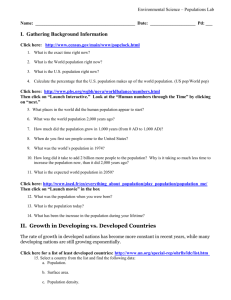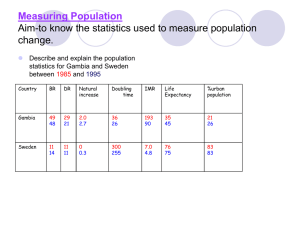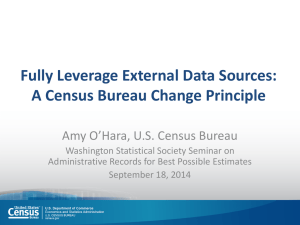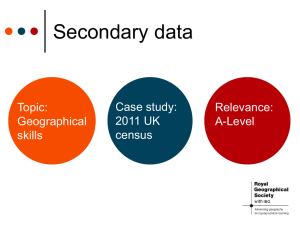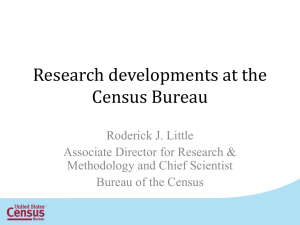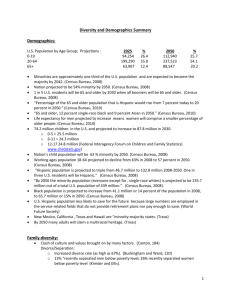How will we Grow? Looking at America to 2050
advertisement
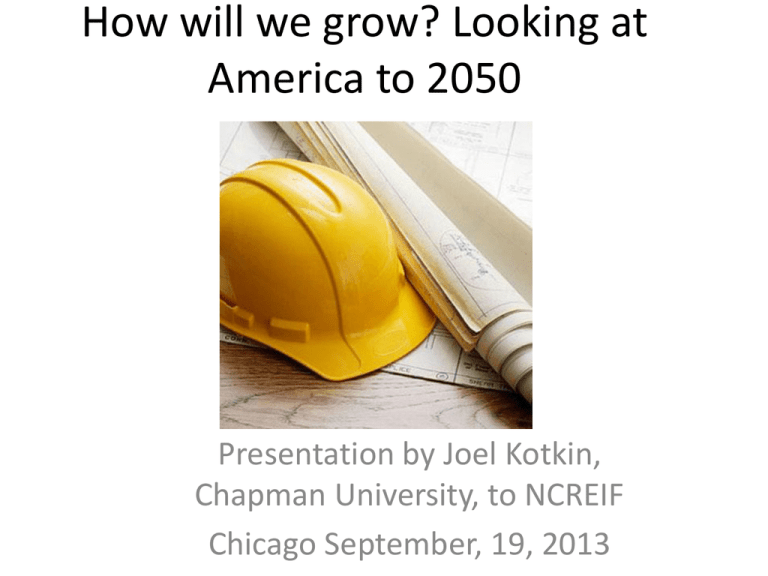
How will we grow? Looking at America to 2050 Presentation by Joel Kotkin, Chapman University, to NCREIF Chicago September, 19, 2013 Long Term Fundamentals • U.S. only advanced country with large, growing population • Huge resource base • Economic system most resilient among advanced countries • Affordable housing attracts key demographic groups • Dispersion and decentralization is the future More Crowding to Come: US Population Growth 1960-2050 400,000,000 350,000,000 300,000,000 250,000,000 200,000,000 150,000,000 100,000,000 50,000,000 0 1960 Source: Bureau of the Census, CensusScope 1970 1980 1990 2000 2010 2030 2050 Labor Force Growth 45% 35% Growth in Age 15-64 United States, 37% 25% 15% 5% -5% China, -10% -15% -25% Europe, -21% Korea, -30% -35% Japan, -39% -45% 2000 2005 2010 2015 2020 2025 2030 2035 2040 2045 2050 U.S. Census Bureau, International Database Ratio of Elderly to Working Age Population 65 & OVER PERSONS PER 15-64 YEARS 0.9 2010 0.8 65 & Over Persons per Under 15 0.82 Calculated from UN Population Prospects: 2010 Revision 2050 0.7 0.6 0.53 0.5 0.45 0.3 0.2 0.37 0.36 0.4 0.34 0.26 0.19 0.12 0.09 0.1 0.0 China Europe Japan Singapore United States Future Drivers of Growth • • Resurgence of Basic Industry • Rise of Growth Corridors • Role of Immigration Millennials, Seniors and the role of families drive dispersion Ag Exports Increasing Driven by solid worldwide demand, increased productivity, and strong commodity prices, America’s ag sector has seen overall export levels steadily increase over the past decade. US Ag Exports, 2000-2011 140.0 Billions of Dollars 120.0 100.0 80.0 60.0 40.0 2000 2001 2002 2003 2004 2005 2006 2007 2008 2009 Source: USDA Economic Research Service 2010 2011 Leading in Gas Production Natural Gas Production, Billions of Cu M United States 611 Russia 589 European Union 182 Canada 152 Iran 139 Qatar Norway China 117 106 97 Netherlands 85 Algeria 85 Saudi Arabia 84 Indonesia 83 CIA World Factbook Shale Oil and Gas- Not Just the Bakken Oil and Gas Extraction Job Growth, 2001-2011 0 20,000 40,000 60,000 80,000 100,000 120,000 140,000 160,000 180,000 200,000 Texas Oklahoma Colorado California Louisiana Pennsylvania Kansas Florida New Mexico North Dakota Ohio Wyoming Arkansas West Virginia Illinois Michigan Mississippi Alaska Utah Source: EMSI Complete Employment, 2011.4 6% Growth Rates: Real GDP vs. Manuafacturing 5.2 5% 4.7 4% 3% 2% 1.7 1% 0% Real GDP 2011 Industrial Production: Manufacturing 2011 Feb. 2011 to Feb. 2012 A High Economic Multiplier Activity Generated by $1 of Sector GDP STEM Occupation Growth, 2002-2012 Seattle-Tacoma-Bellevue, WA 25.5% Houston-Sugar Land-Baytown, TX 20.5% Austin-Round Rock-San Marcos, TX 16.8% San Diego-Carlsbad-San Marcos, CA 11.7% Dallas-Fort Worth-Arlington, TX 11.5% San Francisco-Oakland-Fremont, CA Nation Boston-Cambridge-Quincy, MA-NH San Jose-Sunnyvale-Santa Clara, CA 11.0% 7.5% 5.7% 4.1% Los Angeles-Long Beach-Santa Ana, CA -1.5% Source: EMSI Class of Worker Employment, 2012.2 MAP by Forbes Magazine 2013-2023 JOB GROWTH % CHANGE Research by EMSI, Inc. 30.0% 25.0% 20.0% 15.0% 10.0% 5.0% 0.0% -5.0% 2013-2023 % change 2003-2013 % change Population trends 2012 Population 2001-2012 Growth 2013-2023 Projection Great Lakes 58,204,741 3% 1% Plains 40,198,802 14% 6% Inland West 31,937,817 21% 7% Left Coast 18,754,371 10% 5% NE 41,377,960 6% 3% SoCal 20,738,971 10% 5% SE 60,684,462 14% 5% Third Coast 16,421,390 16% 7% Miami 5,729,000 12% 6% NY 19,109,549 3% 3% Domestic Migration by State: 2000-2009 10 LARGEST STATES FL TX NC GA PA Data from Census Bueau OH MI IL CA NY -2.0 -1.5 -1.0 -0.5 0.0 0.5 Millions: Net Domestic Migration 1.0 1.5 Gaining States Declustering: The New Demography • Nationwide people heading to smaller towns and cities • Shift to opportunity regions • Social trends strongly prosuburban • US Population growth will increase interest “flyover country” Net Domestic Migration by Population MAJOR METROPOLITAN AREAS: 2000-09, 2010-12 4% 3.7% Share of 2000 Population 2% 1.4% 0% Over 10M -2% 5M-10M -2.5% 2.5M-5M 0.6% 1M-2.5M -4% -6% From Census Bureau Data -8% -10% -12% -11.3% Other PROJECTED CHANGE IN HOUSEHOLDS 2012-2017 Research by Pitney Bowes Corp. 8.00% 7.00% 6.00% 5.00% 4.00% 3.00% 2.00% 1.00% 0.00% Housing Affordability: 15 Largest MSAs U.S. Average New York Los Angeles Chicago Dallas-Fort Worth Houston Philadelphia Washington Miami Atlanta Boston San Francisco Riverside-San Bernardino Phoenix Detroit Seattle Salt Lake City 3.1 6.2 6.2 3.2 2.9 3 3.8 4.1 4.5 2 5.2 7.8 3.7 3 1.5 4.8 3.7 0 1 2 3 4 5 6 Median Multiple 7 8 9 Housing Preferences: Realtors Survey 2011 COMMUNITY PREFERENCE SURVEY Attached 7% Other 5% Multi-Unit 8% Detached 80% Figure 25 Population Growth by Distance from Core US MAJOR METROPOLITAN AREAS: 2000-2010 9,000,000 8,000,000 Data from Census Bureau Population Growth 7,000,000 6,000,000 5,000,000 8,566,000 4,000,000 3,000,000 2,000,000 3,473,000 2,989,000 1,000,000 0 -1,000,000 1,105,000 206,000 -272,000 Figure 26 Fastest Growing Counties Over 100,000 2010-2012 Williamson, TX 7.94% Loudon, VA 7.87% Hays, TX 7.56% Orleans, LA 7.39% Fort Bend, TX 7.16% Midland, TX 7.14% Data from Census Bureau Forsyth, GA 7.07% Montgomery, TN 7.04% Prince William, VA 7.04% Osceola, FL 6.97% 0% 2% 4% 6% 8% Groups Shaping our Future Demography – • Key demographic groups: Immigrants, Millennials, Aging Boomers --- mostly in suburbs • Millennials start to grow up • Shift in geography of family: key to long-term growth White-Non-Hispanic Share of Population US: 1960-2050 100% 90% Source: Bureau of the Census 80% 70% 60% 50% 40% 30% 20% 10% 0% 1960 2010 2020 Projection Figure 30 Foreign Born Share of New Households US: 1970-2010 70% 60% 50% Source: Myers & Pitkin 40% 30% 20% Total 10% Owner Renter 0% 1970-1980 1980-1990 1990-2000 2000-2010 Figure 31 Immigration Rates Top 15 Regions Annual Average, 2001-2008 Miami Los Angeles San Francisco New York Dallas Houston Washington Phoenix Chicago Atlanta Boston Seattle Riverside Detroit Philadelphia 10.1 8.0 7.5 7.4 6.5 6.5 6.0 5.8 5.2 4.8 4.6 4.1 3.3 2.5 2.1 Areas are MSA U.S. Census Population Estimates Growth in Foreign Born Population, 2000-2011 Nashville-Davidson--Murfreesboro--Franklin, TN 118.3% Charlotte-Gastonia-Rock Hill, NC-SC 100.4% Memphis, TN-MS-AR 73.0% Kansas City, MO-KS 68.4% Atlanta-Sandy Springs-Marietta, GA 67.5% Oklahoma City, OK 64.9% Tampa-St. Petersburg-Clearwater, FL 50.3% Houston-Sugar Land-Baytown, TX 48.7% Dallas-Fort Worth-Arlington, TX 46.0% Salt Lake City, UT 39.0% Denver-Aurora-Broomfield, CO 34.4% United States 29.8% Boston-Cambridge-Quincy, MA-NH 28.1% Miami-Fort Lauderdale-Pompano Beach, FL Chicago-Joliet-Naperville, IL-IN-WI New York-Northern New Jersey-Long Island, NY-… Los Angeles-Long Beach-Santa Ana, CA 23.4% 15.4% 13.8% 2.6% U.S. Census 2000 and American Community Survey Millions Number of 65 - 100 year olds in United States 2050, 88.55 Million 90 80 2030, 72.09 Million 70 60 50 2008, 38.69 Million 40 30 20 10 0 2000 2002 2004 2006 2008 2010 2012 2014 2016 2018 2020 2022 2024 2026 2028 2030 2032 2034 2036 2038 2040 2042 2044 2046 2048 2050 NewGeography.com Source: Praxis Strategy Group Analysis of U.S. Census Population Projections, Released 2008 Empty Nesters: To Less Dense Areas MAJOR METROPOLITAN & SMALLER AREAS 6.0% 4.0% Change in Share of Cohort 2.0% 0.0% -2.0% -4.0% Major Metro Core Cities Major Metro Suburbs Smaller Areas -6.0% -8.0% -10.0% -12.0% -14.0% 65-74 Population in 2010 Compared to 55-64 in 2000 Source: US Census Data 90% of people over fifty would rather stay put than move - AARP “They don’t want to move to Florida, and they want to stay close to the kids. What they are looking for is a funky suburban development – funky but safe.” - Washington-area developer Jeff Lee. Photo: Vlastula Millennials rival Boomers Population in Millions 81.6 81.0 57.3 Millennials (Age 12 - 30) Gen X (Age 31 - 44) Boomers (Age 45 - 64) U.S. Census Population Projections, 2008 Number of 30 - 45 year olds in United States Millions 2050, 88.09 Million 90 2025, 74.73 Million 80 2010, 66.14 Million 70 60 50 40 30 20 10 0 2000 2002 2004 2006 2008 2010 2012 2014 2016 2018 2020 2022 2024 2026 2028 2030 2032 2034 2036 2038 2040 2042 2044 2046 2048 2050 Source: Praxis Strategy Group Analysis of U.S. Census Population Projections, Released 2008 Millennials and the Family Sources of Happiness of 13-24 year olds 76 85% plan to get married 72 53 52 43 35 77% probably or definitely want children Associated Press/MTV Survey, 2007 Millennial Life Style Choices COMPARED TO OLDER GENERATIONS Current Residence Big City Suburb Source: Frank N. Magid Associates Small City Country Millenials Older Generations Ideal Place to Live Big City Suburb Small City Country 0% 10% 20% 30% 40% 50% Figure 40 Absolute Change: College Graduates HOUSING AFFORDABILITY: MAJOR METRO AREAS: 2007-9 Change in College Graduates: 2007-2009 6% 5% 4% 3% 2% 1% 52 Metropolitan Areas over Million Population 2007 0% Under 3.0 3.0-4.0 4.0-5.0 5.0-6.0 6.0-8.0 Median House Price/Median Household Income: 2007 Over 8 Change in 5-17 Population: 2000-2010 MAJOR METROPOLITAN AREA EXAMPLES 60% Source: Census Data 50% 40% 30% 20% 10% 0% -10% -20% Change No matter how many communes anybody invents, the family always creeps back. Margaret Mead JOELKOTKIN.COM A vivid snapshot of America in 2050 focusing on the evolution of the more intimate units of American society—families, towns, neighborhoods, industries. It is upon the success or failure of these communities that the American future rests. Questions and Comment

